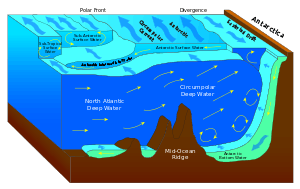Ridge push
Ridge push or sliding plate force is a proposed mechanism for plate motion in plate tectonics. Because mid-ocean ridges lie at a higher elevation than the rest of the ocean floor, gravity causes the ridge to push on the lithosphere that lies farther from the ridge.
As molten magma rises at a mid-ocean ridge it heats the rocks around it. The heat expelled by the magma expands the lithosphere and asthenosphere at the ridge, pushing them above the surrounding ocean floor. As time passes, the heated rocks cool and their density increases. When this happens gravity pulls the weighty lithosphere away from the mid-ocean ridge, down the sloping asthenosphere, which, in turn, allows new molten magma to well up. This fresh magma will eventually become new lithosphere.
The cooling rock exerts a force on spreading lithospheric plates, helping to drive their movements. The force is called ridge push. It can be calculated by the principle of isostasy, making a balance between the mid-ocean ridge and the old ocean floor. Notably, in such a calculation, the force depends only on the temperature of the asthenosphere at the ridge (the same in all 'normal' ridges, though higher at hotspots, and not on the spreading rate of the ridge.
Another force, that for some plates exceeds ridge-push, is slab pull, where the weight of a subducting slab pulls the plate at the surface along.
References
- "Plate tectonics, based on 'Geology and the Environment', 5 ed; 'Earth', 9 ed" (PDF).
- White, R. and Smith, D. (1989). "Magmatism at rift zones: The generation of volcanic continental margins and flood basalts". J. Geophys. Res. 94: 7685–7729. Bibcode:1989JGR....94.7685W. doi:10.1029/JB094iB06p07685.
| ||||||||||||||||||||||||||||

